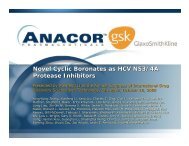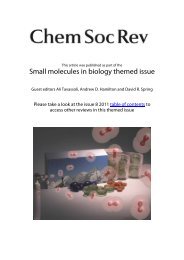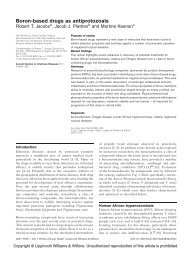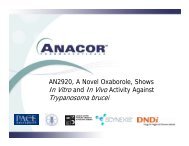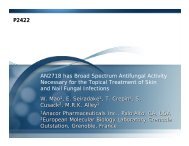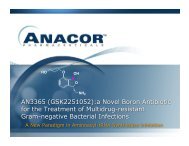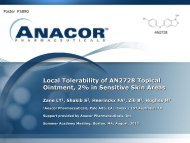The Discovery of GSK2251052: A First-in-Class Boron ... - Anacor
The Discovery of GSK2251052: A First-in-Class Boron ... - Anacor
The Discovery of GSK2251052: A First-in-Class Boron ... - Anacor
Create successful ePaper yourself
Turn your PDF publications into a flip-book with our unique Google optimized e-Paper software.
<strong>The</strong> <strong>Discovery</strong> <strong>of</strong> <strong>GSK2251052</strong>: A <strong>First</strong>-<strong>in</strong>-<strong>Class</strong><br />
<strong>Boron</strong>-Conta<strong>in</strong><strong>in</strong>g Antibacterial Agent Target<strong>in</strong>g<br />
Leucyl tRNA Synthetase<br />
V<strong>in</strong>cent Hernandez<br />
Director, Medic<strong>in</strong>al Chemistry<br />
<strong>Anacor</strong> Pharmaceuticals, Inc. Palo Alto, CA<br />
vhernandez@anacor.com
2<br />
Talk Summary<br />
<strong>GSK2251052</strong><br />
Drug resistant bacteria are a global threat to health care<br />
– Resistance is a natural response to the selective pressure caused by antibiotic use<br />
– New drugs, and particularly new drug classes, are desperately needed to combat<br />
exist<strong>in</strong>g cl<strong>in</strong>ical resistance<br />
Target-based HTS was not successfully applied to antibacterial research<br />
– Most antibiotics are based on natural products<br />
– Antibacterial ‘drug space’ is different from other therapeutic areas<br />
– New approaches (or chemistries) are needed<br />
<strong>Boron</strong> is underexploited <strong>in</strong> medic<strong>in</strong>al chemistry and has tremendous potential <strong>in</strong><br />
drug discovery<br />
<strong>GSK2251052</strong> <strong>in</strong>hibits bacterial Leucyl tRNA synthetase and represents a new<br />
class <strong>of</strong> Gram-negative antibacterial agents<br />
This novel mechanism <strong>of</strong> action means <strong>GSK2251052</strong> is not affected by exist<strong>in</strong>g<br />
modes <strong>of</strong> target-specific cl<strong>in</strong>ical resistance<br />
<strong>GSK2251052</strong> is the first novel mechanism <strong>of</strong> action agent to reach Phase II<br />
cl<strong>in</strong>ical development for the treatment <strong>of</strong> Gram-negative bacterial <strong>in</strong>fections <strong>in</strong><br />
30 years
Bacterial Infections <strong>in</strong> Pre-antibiotic Times<br />
3
4<br />
Antibiotic Resistance is a Global Threat to<br />
Healthcare Today
5<br />
Antibiotic Resistance is Increas<strong>in</strong>g But New<br />
Drug Approvals are Cont<strong>in</strong>u<strong>in</strong>g to Decl<strong>in</strong>e<br />
BIG PHARMA<br />
BIG PHARMA<br />
Modified from Cooper and Shlaes Nature 2011, 472, 32<br />
We desperately need novel MOA drugs to combat bacterial resistance<br />
Much <strong>of</strong> Big Pharma has left antibacterial drug discovery to pursue<br />
more lucrative <strong>in</strong>dications
Lack <strong>of</strong> Novel Antibiotics that Target New<br />
Mechanisms <strong>in</strong> Gram-negative Bacteria<br />
1920 1930 1940 1950 1960 1970 1980 1990 2000 2010<br />
Penicill<strong>in</strong><br />
(β-Lactams)<br />
PBP<br />
Protosil<br />
(Sulfonamides)<br />
DHPS<br />
Streptomyc<strong>in</strong><br />
(Am<strong>in</strong>oglycosices)<br />
30S Ribosome<br />
Chloramphenicol<br />
50S Ribosome PTC<br />
Fosfomyc<strong>in</strong><br />
MurA<br />
Trimethoprim<br />
DHPS<br />
Nalidixic acid<br />
(Qu<strong>in</strong>olones)<br />
Topoisomerase<br />
Mupiroc<strong>in</strong><br />
IleRS<br />
L<strong>in</strong>comyc<strong>in</strong><br />
(L<strong>in</strong>cosamides)<br />
50S Ribosome PTC<br />
Daptomyc<strong>in</strong><br />
Cell Membrane<br />
L<strong>in</strong>ezolid<br />
(Oxazolid<strong>in</strong>ones)<br />
50S Ribosome PTC<br />
Polymix<strong>in</strong> B<br />
LPS<br />
Chlortetracycl<strong>in</strong>e<br />
(Tetracycl<strong>in</strong>es)<br />
30S Ribosome<br />
Pleuromutil<strong>in</strong><br />
50S Ribosome PTC<br />
Novobioc<strong>in</strong><br />
Gyrase<br />
Erythromyc<strong>in</strong><br />
(Macrolides)<br />
50S Ribosome PTC<br />
Vancomyc<strong>in</strong><br />
D-Ala-D-Ala<br />
!<br />
Modified from Lynn Silver (2011) Cl<strong>in</strong>ical Microbiology Reviews 24: 71–109<br />
6
Genomic Revolution did not Improve Antibacterial Lead<br />
Identification: Results <strong>of</strong> GSK’s Target-based HTS<br />
70 HTS were conducted on the most<br />
promis<strong>in</strong>g essential gene targets<br />
GSK library conta<strong>in</strong>ed ~500K<br />
compounds<br />
Only 16 HTS campaigns yielded any hits<br />
Only 5 leads were developed<br />
– Peptide deformylase (PDF)<br />
– Enoyl-acyl carrier prote<strong>in</strong> reductase (FabI)<br />
– 3-ketoacyl-acyl carrier prote<strong>in</strong> III (FabH)<br />
– Methionyl tRNA synthetase (MetRS)<br />
– Phenylalanyl tRNA synthetase (PheRS)<br />
Better leads already existed for PDF<br />
FabI and MetRS were not broad<br />
spectrum and subsequently partnered<br />
with biotech<br />
FabH did not advance beyond lead<br />
Only PheRS was pursued<br />
7<br />
Nat Rev Drug Discov. 2007;6,29-40
Antibacterials Occupy a Different ‘Drug<br />
Space’<br />
•CNS drugs closely follow Lip<strong>in</strong>ski’s rules<br />
•Antibacterials are on average more hydrophilic and larger<br />
8<br />
Nat Rev Drug Discov. 2007;6,29-40
<strong>Boron</strong> Chemistry: A New Approach to Drug <strong>Discovery</strong>
10<br />
<strong>Boron</strong> is Commonly Found <strong>in</strong> Our<br />
Environment<br />
In nature, boron is present as boric acid<br />
Boric acid is the ma<strong>in</strong> <strong>in</strong>gredient <strong>of</strong> Goop<br />
–Children’s brightly colored toy, that they<br />
squeeze through their f<strong>in</strong>gers<br />
Boric acid is used as a preservative <strong>in</strong> eye<br />
wash and vag<strong>in</strong>al creams<br />
Boric acid has an LD 50 similar to regular<br />
table salt (~3000 mg/kg)<br />
<strong>Boron</strong> is an essential plant nutrient<br />
We consume up to 4 mg <strong>of</strong> boron a day,<br />
primarily from fruits, vegetables and nuts<br />
At <strong>Anacor</strong>, we found background levels <strong>of</strong><br />
200 ng/mL <strong>of</strong> boron <strong>in</strong> mouse plasma
11<br />
General Facts on <strong>Boron</strong><br />
<strong>Boron</strong> is commonly found as boric acid <strong>in</strong> our liv<strong>in</strong>g environment<br />
<strong>Boron</strong> is similar to carbon <strong>in</strong> that it can form stable covalent bonds,<br />
<strong>in</strong>clud<strong>in</strong>g carbon-boron bonds<br />
<strong>Boron</strong> has a unique geometry and reactivity with an empty P-orbital
12<br />
<strong>Boron</strong> has a Unique Bond<strong>in</strong>g Orbital<br />
Configuration: An Empty P-Orbital<br />
Trigonal Planar<br />
Tetrahedral<br />
<strong>Boron</strong> has an empty p-orbital & can form a dative bond<br />
under specific conditions<br />
<strong>The</strong> dative bond forms a tetrahedral structure<br />
Exploitation <strong>of</strong> p-orbital expands drug design possibilities
History and Overview <strong>of</strong> <strong>Boron</strong>ic Acid Drug<br />
<strong>Discovery</strong> Efforts<br />
Design <strong>of</strong> boronic acid enzyme <strong>in</strong>hibitors <strong>in</strong>itiated <strong>in</strong> 1980s<br />
Multiple disease targets have been pursued<br />
H 2 N<br />
NH<br />
N<br />
H<br />
O<br />
OH<br />
B<br />
OH<br />
NH<br />
O<br />
N<br />
Thromb<strong>in</strong><br />
Dup 714<br />
NHAc<br />
β-Lactamase Inhibitor<br />
Arg<strong>in</strong>ase Inhibitor<br />
HCV Pr Inhibitor<br />
DPP4 Inhibitor – PHX-1149<br />
Only Velcade has reached FDA approval<br />
Velcade<br />
Baker et al. (2009) Future Medic<strong>in</strong>al Chemistry, 1(7), 1275-1288<br />
13
14<br />
<strong>Class</strong>ical <strong>Boron</strong>ic Acids Have Significant<br />
Limitations<br />
O<br />
H<br />
N<br />
OH<br />
B OH<br />
Most boronic acid enzyme<br />
<strong>in</strong>hibitors conta<strong>in</strong> an aliphatic<br />
carbon-boron bond<br />
Consequences <strong>of</strong> an aliphatic carbon-boron bond<br />
–Chemical reactivity is moderate and can lead to over reactivity<br />
with non-target prote<strong>in</strong>s – poor selectivity & specificity<br />
–Stability problems <strong>of</strong>ten arise via oxidation or proto-debor<strong>in</strong>ation<br />
–Oxidative metabolism can lead to elim<strong>in</strong>ation <strong>of</strong> boron and loss<br />
<strong>of</strong> biological activity<br />
–pKa range <strong>of</strong> 8-9 favors trigonal form <strong>in</strong> aqueous environment<br />
–Can pose synthetic challenges
15<br />
<strong>Anacor</strong>’s Approach to Drug-like Chemical Matter<br />
Create new organo-boron compounds that reta<strong>in</strong><br />
the P-orbital reactivity but with greatly enhanced<br />
chemical and metabolic stability
16<br />
Benzoxaboroles Show Better Drug-like<br />
Properties Compared to <strong>Boron</strong>ic Acids<br />
pK a range <strong>of</strong> 9-10, <strong>in</strong>dicat<strong>in</strong>g<br />
weaker Lewis acid and poorer<br />
water solubility<br />
Freely rotated C-B bond is easily<br />
accessible to nucleophiles, prone<br />
to non-specific b<strong>in</strong>d<strong>in</strong>g or selfaggregation<br />
Aliphatic boron activity (potency,<br />
selectivity) can be difficult to<br />
modulate<br />
Stability & metabolism issues<br />
Well known <strong>in</strong> the literature<br />
pK a range <strong>of</strong> 7-8, <strong>in</strong>dicat<strong>in</strong>g<br />
stronger Lewis acid and better<br />
water solubility<br />
Constra<strong>in</strong>ed C-B bond <strong>in</strong> a fused<br />
r<strong>in</strong>g is more specific & reactive to<br />
targeted nucleophiles, and less<br />
prone to non-specific b<strong>in</strong>d<strong>in</strong>g<br />
Potency/selectivity can be easily<br />
f<strong>in</strong>e-tuned by electronic and<br />
steric effects <strong>of</strong> substitutents<br />
Chemically & metabolically stable<br />
Underexploited <strong>in</strong> MedChem
17<br />
Re-discovery <strong>of</strong> the Benzoxaboroles<br />
Early chemical exploration at <strong>Anacor</strong> <strong>of</strong> a series <strong>of</strong> bor<strong>in</strong>ic<br />
esters led to the isolation <strong>of</strong> a cyclic boronic ester<br />
R<br />
Br<br />
O<br />
O<br />
O B O<br />
nBuLi<br />
R<br />
B<br />
OH<br />
O<br />
O<br />
R 2<br />
R 2 R2<br />
HCl<br />
MeOH<br />
R<br />
B<br />
O<br />
O<br />
B<br />
O<br />
O<br />
O<br />
O<br />
nBuLi<br />
O<br />
O<br />
B<br />
OH<br />
O<br />
O<br />
O<br />
HCl<br />
MeOH<br />
O<br />
B<br />
O<br />
OH<br />
B<br />
O<br />
O<br />
Desired Compound<br />
Isolated Compound
AN2690 (Tavaborole) has Broad-spectrum<br />
Antifungal Activity<br />
Yeast MIC<br />
AN2690<br />
(µg/mL)<br />
S. cerevisiae ATCC 201388 0.12<br />
C. albicans ATCC 90028 0.5<br />
C. albicans (fluconazole resistant) 0.5<br />
C. glabrata ATCC 90030 0.12<br />
C. krusei ATCC 44507 1<br />
C. parapsilosis ATCC 22019 ≤ 0.5<br />
C. tropicalis ATCC 13803 ≤ 0.5<br />
C. ne<strong>of</strong>ormans F285 0.25<br />
M. fufur ATCC 44344 1<br />
M. pachydermatis ATCC 96746 1<br />
M. sympodialis ATCC 44031 1<br />
Mold MIC<br />
AN2690<br />
(µg/mL)<br />
A. fumigatus ATCC 13073 0.25<br />
R. microsporus ATCC 66276 2<br />
A. alternata ATCC 6663 0.5<br />
P. chrysogenum ATCC 10108 2<br />
C. cladosporioides ATCC 16022 0.5<br />
Fusarium solani ATCC 36031 2<br />
Dermatophyte MIC<br />
AN2690<br />
(µg/mL)<br />
T. rubrum (MIC 90 ) 8<br />
T. mentagrophytes (MIC 90 ) 8<br />
T. tonsurans ATCC 28942 2<br />
E. floccosum ATCC 52066 ≤ 0.5<br />
M. audou<strong>in</strong>ii ATCC 42558 2<br />
M. canis ATCC 10214 2<br />
M. gypseum ATCC 24103 2<br />
Currently <strong>in</strong> phase III trials for the topical treatment <strong>of</strong> onychomycosis<br />
Baker et al.(2006) J. Med. Chem. 49: 4447-4450<br />
18<br />
18
19<br />
AN2690 (Tavaborole) was Shown to be Efficacious<br />
and Well Tolerated <strong>in</strong> Phase 2 Cl<strong>in</strong>ical Trials<br />
Efficacy<br />
<strong>Boron</strong>-based compound<br />
– Targets LeuRS to kill fungus<br />
– Physical properties <strong>of</strong><br />
molecule enables nail<br />
penetration<br />
Basel<strong>in</strong>e<br />
Demonstrated efficacy <strong>in</strong> three<br />
Phase 2 trials<br />
Safety<br />
Day 180<br />
Topical drug<br />
Little or no detectable systemic<br />
exposure<br />
All precl<strong>in</strong>ical toxicology<br />
completed
20<br />
Antifungal Tavaborole Validated Leucyl tRNA<br />
Synthetase as a Novel Drug Target<br />
F<br />
OH<br />
B<br />
O<br />
AN2690<br />
Tavaborole<br />
Genetic study <strong>in</strong><br />
Saccharomyces cerevisiae<br />
identified the cytoplasmic<br />
LeuRS gene (CDC60)<br />
LeuRS has two active sites<br />
• Edit<strong>in</strong>g site<br />
• Synthetic site<br />
All mutations mapped to<br />
the edit<strong>in</strong>g doma<strong>in</strong><br />
Rock et al. Science 2007, 316, 1759-1761
21<br />
Leucyl-tRNA synthetase (LeuRS)<br />
Edit<strong>in</strong>g<br />
doma<strong>in</strong><br />
tRNA Leu<br />
C-term<strong>in</strong>al<br />
doma<strong>in</strong><br />
Anticodonb<strong>in</strong>d<strong>in</strong>g<br />
doma<strong>in</strong><br />
LeuRS-tRNA Leu crystal<br />
structure at 2.3 Å<br />
Catalytic<br />
doma<strong>in</strong><br />
Leucylspecific<br />
doma<strong>in</strong><br />
<strong>The</strong> am<strong>in</strong>oacyl-tRNA synthetase LeuRS is<br />
essential for prote<strong>in</strong> synthesis<br />
- Attaches leuc<strong>in</strong>e to the 3’ term<strong>in</strong>al nucleotide<br />
<strong>of</strong> tRNA Leu (A76)<br />
Two active sites separated by 38 Å<br />
- Synthetic active site synthesizes<br />
am<strong>in</strong>oacylated tRNA Leu<br />
- Edit<strong>in</strong>g (pro<strong>of</strong>-read<strong>in</strong>g) active site<br />
- A76 moves between the two active sites<br />
Edit<strong>in</strong>g site ensures fidelity <strong>of</strong> prote<strong>in</strong><br />
synthesis<br />
- Synthetic site can attach isoleuc<strong>in</strong>e, val<strong>in</strong>e,<br />
methion<strong>in</strong>e, norval<strong>in</strong>e and other am<strong>in</strong>o acids<br />
to tRNA Leu<br />
- Edit<strong>in</strong>g site hydrolyzes all am<strong>in</strong>oacyl-tRNA Leu<br />
other than leuc<strong>in</strong>e<br />
- Mischarged tRNA Leu are extremely deleterious<br />
to the cell
22<br />
Bacterial and Eukaryotic LeuRS are Different<br />
Archeal/<br />
Eukaryotic<br />
edit<strong>in</strong>g<br />
catalytic<br />
HIGH<br />
15 % id.<br />
KMSKS<br />
ABD<br />
C-ter1<br />
A<br />
C<br />
C<br />
A<br />
edit<strong>in</strong>g<br />
LS<br />
A<br />
C<br />
C<br />
A<br />
Bacterial<br />
HIGH<br />
catalytic<br />
KMSKS<br />
ABD<br />
C-ter2<br />
28 % identity<br />
Mitochondrial LeuRS is edit<strong>in</strong>g defective<br />
- (Lue & Kelly Biochem (2005) 44: 3010)
X-ray Structure Revealed A tRNA Leu Adduct <strong>in</strong><br />
the Edit<strong>in</strong>g Site <strong>of</strong> Leucyl tRNA Synthetase<br />
AN2690-A76 Adduct<br />
In Edit<strong>in</strong>g Site<br />
Leuc<strong>in</strong>e<br />
<strong>in</strong><br />
Synthesis Site<br />
tRNA<br />
O<br />
O<br />
P<br />
O -<br />
O<br />
O<br />
N<br />
N<br />
NH 2<br />
N<br />
N<br />
O<br />
O<br />
B<br />
O<br />
F<br />
LeuRS<br />
Rock et al. (2007) Science 316:1759-1761<br />
23<br />
tRNA Leu
24<br />
AN2690 Forms a Bi-dentate Adduct to the<br />
Term<strong>in</strong>al Ribose <strong>of</strong> tRNA leu<br />
Rock et al. Science 2007, 316, 1759-1761
AN2690 Traps tRNA Leu <strong>in</strong> Edit<strong>in</strong>g Site and<br />
Inhibits Am<strong>in</strong>oacylation<br />
Prevents am<strong>in</strong>oacylation <strong>of</strong><br />
tRNA Leu , which ultimately leads<br />
to a block <strong>in</strong> prote<strong>in</strong> synthesis<br />
<strong>Boron</strong> is absolutely essential<br />
Carbon and other analogues<br />
are <strong>in</strong>active<br />
AN2690-tRNA Leu<br />
Rock et al. Science 2007, 316, 1759-1761.<br />
25 25
Benzoxaborole R<strong>in</strong>g is Essential for<br />
Inhibition <strong>of</strong> Fungal LeuRS<br />
Structure IC50 (μM) Structure IC50 (μM)<br />
2.1 >100<br />
96 >100<br />
>100 >100<br />
>100<br />
<strong>Boron</strong> and the oxaborole r<strong>in</strong>g<br />
are required for <strong>in</strong>hibition <strong>of</strong><br />
am<strong>in</strong>oacylation.<br />
Rock et al. Science 2007, 316, 1759-1761.<br />
26
27<br />
AN2690 had Poor In vitro Activity Aga<strong>in</strong>st<br />
Gram-negative Bacteria<br />
IC 50<br />
*(µM)<br />
MIC (µg/mL)<br />
Compound<br />
E. coli<br />
P. aerug<strong>in</strong>osa<br />
S. cerevisiae<br />
Ac<strong>in</strong>etobacter<br />
sp. ATCC15473<br />
E. coli K12<br />
K. pneumoniae<br />
ATCC 700603<br />
P. aerug<strong>in</strong>osa<br />
ATCC 27853<br />
AN2690<br />
F<br />
OH<br />
B<br />
O<br />
9.9 7.9 0.06 32 8 32 >64<br />
AN2690 showed poor biochemical potency and weak bacterial MIC<br />
pr<strong>of</strong>iles<br />
- E. coli LeuRS <strong>of</strong>f-rate was very fast<br />
X-ray structure <strong>of</strong> AN2690/LeuRS suggests that more <strong>in</strong>teractions<br />
could be obta<strong>in</strong>ed by <strong>in</strong>corporat<strong>in</strong>g appropriate substituents<br />
* IC 50 determ<strong>in</strong>ed after 20 m<strong>in</strong>utes pre-<strong>in</strong>cubation with enzyme and tRNA
X-ray Structure <strong>of</strong> AN2690 <strong>in</strong> Bacterial LeuRS<br />
Revealed a Key B<strong>in</strong>d<strong>in</strong>g Site was not Utilized<br />
Tyr-327<br />
Leu-329<br />
Tyr-327<br />
Leu-329<br />
Asp-347<br />
Ile-337<br />
Asp-347<br />
Ile-337<br />
Val-340<br />
Thr-252<br />
Met-338<br />
Tyr-332<br />
Thr-248<br />
Val-340<br />
Thr-252<br />
Met-338<br />
Thr-248<br />
Norval<strong>in</strong>e post-transfer substrate analogue<br />
AN2690-AMP<br />
L<strong>in</strong>cecum et al. Molecular Cell 2003, 11, 951-963 Rock et al. Science 2007, 316, 1759-1761<br />
28
29<br />
3-Am<strong>in</strong>omethyl Substitution was Added<br />
to Ga<strong>in</strong> <strong>The</strong>se Key H-bonds<br />
Nva2aa<br />
AN2690<br />
Nva2aa<br />
AN3334
Addition <strong>of</strong> 3-Am<strong>in</strong>omethyl to Benzoxaborole<br />
Made Three Hydrogen Bonds with LeuRS<br />
Leu-327<br />
Asp-345<br />
Asp-342<br />
Glu-329<br />
Val-338<br />
Tyr-330<br />
E. coli LeuRS IC 50<br />
Thr-252<br />
Met-336<br />
Thr-248<br />
27.5 μM<br />
Thr-247<br />
Ser-227<br />
1.0 μM(AN3334)<br />
Alley et al. ICAAC 2009 F1-1223a<br />
30
31<br />
Improv<strong>in</strong>g Spectrum <strong>of</strong> Activity for AN3334<br />
Was Focus <strong>of</strong> Lead Optimization<br />
Stra<strong>in</strong><br />
No. <strong>of</strong><br />
stra<strong>in</strong>s<br />
AN3334<br />
Tigeccyl<strong>in</strong>e<br />
Imipenem<br />
P. aerug<strong>in</strong>osa (WT) 50 1 16 1 8 2 4 16 32 >64 >64<br />
P. aerug<strong>in</strong>osa (MbL-) 25 1 >16 32 >32 >16 >16 >32 >128 >64 >64<br />
P. aerug<strong>in</strong>osa (MbL+) 26 1 >16 >64 >32 >16 >16 >32 >128 >64 >64<br />
A. baumannii (WT) 25 >128 1 0.25 8 4 2 16 8 32 32<br />
Ac<strong>in</strong>etobacter spp. (MDR) 26 >128 8 64 >32 >16 >16 >32 >128 >64 >64<br />
S. maltophilia (WT) 50 1 1 >64 >32 4 >16 >32 >128 >64 >64<br />
B. cepacia 50 4 4 16 32 8 >16 16 32 >64 >64<br />
E. coli (WT) 27 1 0.25 0.12 ≤1 >16 2 ≤1 8 32 >64<br />
E. coli (ESBL) 25 2 0.25 0.25 >32 >16 >16 >32 128 64 >64<br />
Klebsiella spp. (WT) 25 1 0.5 0.25 ≤1 ≤0.5 1 ≤1 16 8 >64<br />
Klebsiella spp. (ESBL) 15 1 2 1 >32 16 >16 >32 >128 64 >64<br />
Klebsiella spp. (KPC) 10 2 1 >64 >32 >16 16 >32 >128 >64 >64<br />
Enterobacter spp. (WT) 25 1 0.5 1 ≤1 ≤0.5 ≤0.5 2 8 >64 >64<br />
Enterobacter spp. (AmpC) 26 1 4 0.5 8 >16 >16 >32 >128 >64 >64<br />
Citrobacter spp. (WT) 36 1 0.5 1 ≤1 1 >16 2 16 >64 >64<br />
Citrobacter spp. (AmpC) 16 0.5 0.5 1 2 16 2 >32 128 >64 >64<br />
P. mirabilis (WT) 42 128 4 2 ≤1 2 2 ≤1 0.5 8 >64<br />
P. mirabilis (ESBL) 11 >128 4 2 >32 >16 >16 >32 4 64 >64<br />
P. vulgaris (WT) 20 >128 2 2 ≤1 ≤0.5 1 ≤1 0.5 16 >64<br />
M. morganii (WT) 17 2 2 4 ≤1 4 2 4 2 >64 >64<br />
Indole positive Proteae 14 16 2 2 ≤1 16 4 ≤1 4 >64 >64<br />
S. marcenscens (WT) 38 0.5 1 1 ≤1 1 1 2 32 >64 >64<br />
S. marcenscens (AmpC) 16 0.5 2 1 4 4 >16 >32 64 >64 >64<br />
Key: Red = resistant, Yellow = <strong>in</strong>termediate and Green = susceptible based on CLSI <strong>in</strong>terpretive criteria (M100‐S21, 2011), except for<br />
AN3334 (susceptible def<strong>in</strong>ed as MICs ≤4 mcg/mL), tigecycl<strong>in</strong>e (FDA <strong>in</strong>terpretive criteria used to def<strong>in</strong>e susceptibility) and polymix<strong>in</strong>B<br />
(susceptible ≤ 2mcg/mL , <strong>in</strong>termediate 4 mcg/mL, resistant ≥8 mcg/mL)<br />
Cefepime<br />
Lev<strong>of</strong>loxac<strong>in</strong><br />
Gentamic<strong>in</strong><br />
Ceftazidime<br />
Piperacill<strong>in</strong>/<br />
tazobactam<br />
Amoxycill<strong>in</strong>/<br />
clavulanate<br />
Ampicill<strong>in</strong>
32<br />
7-Hydroxyl Substitution Identified Another<br />
Interaction with Phosphate <strong>of</strong> tRNA<br />
Asp-342<br />
Asp-342<br />
P75<br />
Leu-327<br />
Glu-329<br />
E. coli LeuRS IC 50<br />
Thr-252<br />
Met-336<br />
Thr-248<br />
Tyr-330<br />
Ser-227<br />
27.5 μM<br />
Thr-247<br />
1.4 μM (AN3016)
33<br />
Key Interactions Identified <strong>in</strong> X-ray Structures<br />
were Comb<strong>in</strong>ed <strong>in</strong> AN3365/<strong>GSK2251052</strong><br />
OH<br />
OH<br />
OH<br />
B<br />
O<br />
AN3334<br />
NH 2<br />
+<br />
O<br />
AN3016<br />
OH<br />
B<br />
O<br />
O<br />
OH<br />
B<br />
O<br />
NH 2<br />
<strong>GSK2251052</strong><br />
A 76<br />
Arg 344<br />
A 76<br />
A 76<br />
Thr 248<br />
Asp 342<br />
Thr 248<br />
Arg 344<br />
Thr 248<br />
Asp 342<br />
Asp 345<br />
Thr 247<br />
AN3334<br />
Asp 345<br />
Thr 247<br />
AN3016<br />
Asp 345<br />
Asp 342<br />
Thr 247<br />
<strong>GSK2251052</strong><br />
Hernandez et al. ICAAC 2010 F1-1637
34<br />
<strong>GSK2251052</strong> has Broader Spectrum than AN3334 with<br />
Activity Aga<strong>in</strong>st Proteae and Ac<strong>in</strong>etobacter <strong>in</strong> Primary Panel<br />
E.coli<br />
K.pneumoniae<br />
Compound LeuRS IC50 ATCC29522 CTM-2,OXA-2 K12 WT K12 tolC ATCC42816 KPC2 ATCC27853 PA01 WT PA01 pumpless ATCC15473 BAA1710 IMP BAA-663<br />
Cipr<strong>of</strong>loxac<strong>in</strong> N/A 6.4<br />
Meropenem N/A 64<br />
Tigecycl<strong>in</strong>e N/A 64 0.5 0.5 0.25 1 >64 8 >64<br />
AN3334 1.0 uM 1 1 2 2 1 0.5 2 2 1 >64 >64 2 >64<br />
AN3016 1.36 uM 4 16 8 2 16 16 >64 >64 8 4 8 NT 32<br />
GSK'052 0.31 uM 1 1 2 2 1 1 2 1 0.5 1 2 1 1<br />
4 >100 uM 64 >64 >64 >64 64 64 >64 >64 64 >64 >64 NT >64<br />
P.aerug<strong>in</strong>osa<br />
A.baumannii<br />
E.cloacae<br />
P.mirabilis<br />
FDA approved breakpo<strong>in</strong>ts for tigecycl<strong>in</strong>e and CLSI susceptibility criteria were used (green=S, yellow=I,<br />
red=R). Polymyx<strong>in</strong> B breakpo<strong>in</strong>ts for P. aerug<strong>in</strong>osa were used for Enterobacteriaceae. For the <strong>Anacor</strong><br />
compounds they were color coded as green ≤ 4 ug/mL, yellow = 8-16 µg/mL, Red ≥32 µg/mL.
35<br />
<strong>GSK2251052</strong> In Vitro Activity: Enterobacteriaceae,<br />
Includ<strong>in</strong>g Multidrug-Resistant Stra<strong>in</strong>s<br />
Key: Red = resistant, Yellow = <strong>in</strong>termediate and Green = susceptible based on CLSI <strong>in</strong>terpretive criteria (M100‐S21,<br />
2011), except for <strong>GSK2251052</strong> (susceptible def<strong>in</strong>ed as MICs ≤4 mcg/mL), tigecycl<strong>in</strong>e (FDA <strong>in</strong>terpretive criteria used<br />
to def<strong>in</strong>e susceptibility) and polymix<strong>in</strong>B (susceptible ≤ 2mcg/mL , <strong>in</strong>termediate 4 mcg/mL, resistant ≥8 mcg/mL)
36<br />
<strong>GSK2251052</strong>: Pre-Cl<strong>in</strong>ical In vitro<br />
Frequency <strong>of</strong> Resistance<br />
Compound<br />
Frequency <strong>of</strong> Resistance<br />
E. coli K. pneumoniae P. aerug<strong>in</strong>osa<br />
4xMIC 10xMIC 4xMIC 10xMIC 4xMIC 10xMIC<br />
<strong>GSK2251052</strong> 8x10 ‐8 6x10 ‐8 5x10 ‐8 4x10 ‐8 1x10 ‐7 5x10 ‐8<br />
2x10 ‐7 7x10 ‐8 8x10 ‐7 6x10 ‐8 2x10 ‐7 9.6x10 ‐8<br />
1x10 ‐7 8x10 ‐8 4x10 ‐8 2x10 ‐8<br />
Ceftazidime
37<br />
<strong>GSK2251052</strong>: Pre-Cl<strong>in</strong>ical Mechanism<br />
<strong>of</strong> Resistance<br />
Laboratory generated mutants resistant to <strong>GSK2251052</strong> conta<strong>in</strong> mutations<br />
<strong>in</strong> the LeuRS edit<strong>in</strong>g doma<strong>in</strong><br />
– S<strong>in</strong>gle-step mutations <strong>in</strong> leuS<br />
<strong>GSK2251052</strong> MICs <strong>of</strong> resistant mutants range from 32->256 mcg/mL<br />
Organism<br />
<strong>GSK2251052</strong> MIC (mcg/ml)<br />
WT<br />
Mutants<br />
E. coli 1 64‐>256<br />
K. pneumoniae 1 256‐>256<br />
P. aerug<strong>in</strong>osa 4 32‐>256<br />
– <strong>GSK2251052</strong> resistant mutants do not confer cross-resistance to other<br />
antibiotics and appear to be edit<strong>in</strong>g deficient
Synthesis <strong>of</strong> <strong>GSK2251052</strong>
39<br />
Initial Medchem Synthesis Relied on Chiral<br />
Prep-HPLC Separation <strong>of</strong> Enantiomers
40<br />
Improved Medchem Process was used to<br />
Produce Phase I Cl<strong>in</strong>ical Trial Material<br />
OH<br />
OH<br />
BnO<br />
Br<br />
O<br />
OH<br />
OBn<br />
Tf 2 O, Pyrid<strong>in</strong>e<br />
O<br />
OTf<br />
OBn<br />
CHO<br />
t-BuONa, DMSO<br />
rt, O/N<br />
quantitative<br />
CHO<br />
DCM, rt, 3 h<br />
64-88%<br />
CHO<br />
O O<br />
BB<br />
O O<br />
PdCl 2 (dppf), KOAc<br />
THF or dioxane<br />
50-75%<br />
BnO<br />
O<br />
OH<br />
B<br />
O<br />
NaOH(aq.), CH 3 NO 2<br />
THF, 0 o Ctort,O/N<br />
55-60%<br />
BnO<br />
O<br />
O<br />
B O<br />
CHO<br />
NO 2<br />
50% yield<br />
1)Pd(OH) 2 ,NH 3 <strong>in</strong> MeOH<br />
2) HCl <strong>in</strong> MeOH<br />
HO<br />
O<br />
AN3213<br />
(racemic)<br />
OH<br />
B<br />
O<br />
NH 2 .HCl<br />
HO<br />
1) NH 3 <strong>in</strong> MeOH<br />
2) R-(-)-mandelic acid<br />
3) aq. HCl<br />
47% yield<br />
O<br />
<strong>GSK2251052</strong><br />
OH<br />
B<br />
O<br />
NH 2 .HCl
41<br />
Process Research at GSK Identified a<br />
Stereospecific Route to <strong>GSK2251052</strong><br />
Conde, JJ. WO 2011127143
Systemic Treatment with <strong>GSK2251052</strong> Shows Good<br />
Distribution with no Accumulation <strong>in</strong> Tissues<br />
Figure 1. Whole-body autoradiograph for male Long Evans Rat at 1, and 72 h after a<br />
s<strong>in</strong>gle <strong>in</strong>travenous adm<strong>in</strong>istration <strong>of</strong> 14C-<strong>GSK2251052</strong> (Group 5, 50 mg/kg)<br />
Liu et al. N. American Regional ISSX 2011 P-84<br />
42
43<br />
<strong>GSK2251052</strong> Phase 1 Results Showed L<strong>in</strong>ear PK<br />
with Blood Levels Reach<strong>in</strong>g <strong>in</strong> Excess <strong>of</strong> MIC90 Levels<br />
IV Dose<br />
Mean AUC*<br />
(h.µg/ml)<br />
Mean Cmax*<br />
(µg/ml)<br />
MAD 1 500 mg BID x 8 days 56 9.4<br />
MAD 2 750 mg BID x 14 days 76 11.5<br />
MAD 3 1200 mg BID x 14 days 117 19.1<br />
MAD 4 2000 mg BID x 14 days 193 31<br />
*Mean PK parameter for last day <strong>of</strong> dos<strong>in</strong>g
Recreat<strong>in</strong>g Human PK Pr<strong>of</strong>iles <strong>in</strong> Rat Infection<br />
Models<br />
Rats receive cont<strong>in</strong>uous IV <strong>in</strong>fusion via jugular cannula<br />
– Infusion delivered by peristaltic pump<br />
– Flow rates <strong>of</strong> <strong>in</strong>fusion controlled by computer<br />
– Rates change every 15 m<strong>in</strong>utes to recreate<br />
human concentration pr<strong>of</strong>ile <strong>in</strong> rat blood<br />
‘052 tested <strong>in</strong> lung and thigh <strong>in</strong>fection models<br />
• Blood samples collected to confirm PK pr<strong>of</strong>iles<br />
• Animals receive 4 days <strong>of</strong> therapy<br />
All studies were conducted after review by the Institutional Animal Care and Use Committee at GSK<br />
and <strong>in</strong> accordance with the GSK Policy on the Care, Welfare and Treatment <strong>of</strong> Laboratory Animals<br />
44
45<br />
Efficacy <strong>of</strong> Recreated Human IV Exposure Pr<strong>of</strong>iles<br />
Dosed BID <strong>in</strong> Rat Lung and Thigh Infection Models<br />
Daily AUC 60 ug.h/ml<br />
Cmax 10 ug/ml<br />
K. pneumoniae ANA588 (lung)<br />
500mg pr<strong>of</strong>ile for ‘052<br />
Daily AUC 120 ug.h/ml<br />
Cmax 18 ug/ml<br />
MIC=0.5<br />
MIC>64<br />
MIC=0.125<br />
E. coli 343659 (thigh)<br />
500mg pr<strong>of</strong>ile for ‘052<br />
P. aerug<strong>in</strong>osa 1483518 (thigh)<br />
1200mg pr<strong>of</strong>ile for ‘052<br />
MIC>64<br />
MIC>16<br />
MIC>64<br />
MIC=0.5<br />
MIC=0.25<br />
MIC=4
Phase II Cl<strong>in</strong>ical Studies<br />
LRS114689: Comparative, dose-rang<strong>in</strong>g study <strong>of</strong> <strong>GSK2251052</strong> vs.<br />
meropenem <strong>in</strong> <strong>in</strong> the treatment <strong>of</strong> complicated <strong>in</strong>tra-abdom<strong>in</strong>al <strong>in</strong>fection<br />
LRS114688: Comparative, dose-rang<strong>in</strong>g study <strong>of</strong> <strong>GSK2251052</strong> vs.<br />
imipenem-cilastat<strong>in</strong> <strong>in</strong> complicated lower ur<strong>in</strong>ary tract <strong>in</strong>fection and<br />
pyelonephritis<br />
– Both studies are dose rang<strong>in</strong>g , 750mg:1500mg twice a day: Active Comparator<br />
– 210 subjects per study<br />
– Independent Safety Review Committee<br />
– Decide on the most appropriate and safe dose for Phase III<br />
In PH2 cUTI study 4 <strong>of</strong> 14 patients (20 patients enrolled) saw a rapid<br />
emergence <strong>of</strong> mutants with high <strong>GSK2251052</strong> MIC values<br />
– Mutations were <strong>in</strong> leuS<br />
In PH2 cIAI study no resistance mutants were discovered <strong>in</strong> 15 patients<br />
enrolled<br />
Work is ongo<strong>in</strong>g to determ<strong>in</strong>e future development options for<br />
<strong>GSK2251052</strong><br />
46
47<br />
Talk Summary<br />
Multi-drug resistant bacteria is a global health threat<br />
New approaches are needed to f<strong>in</strong>d novel antibacterial agents<br />
<strong>Boron</strong> is underexploited <strong>in</strong> medic<strong>in</strong>al chemistry and has tremendous<br />
potential <strong>in</strong> drug discovery<br />
AN3365/<strong>GSK2251052</strong> <strong>in</strong>hibits bacterial LeuRS and is the first Gramnegative<br />
antibacterial with a truly novel mechanism <strong>of</strong> action to reach<br />
phase II trials <strong>in</strong> over 30 years
Acknowledgements<br />
To Everyone at ANACOR especially<br />
<strong>Discovery</strong> Biology: M.R.K. Alley, J. Fong,<br />
W. Mao, M. Mohan, M. Meewan, F. Rock,<br />
Pharmacology: P. Torres, H. Sexton,<br />
Y. Freund<br />
Computational Chemistry: Y. Zhou, D.<br />
Sullivan<br />
Medic<strong>in</strong>al Chemistry: T. Akama, YK<br />
Zhang, Y. Zhang, J. Plattner<br />
PKDM: XQ. Fan, W. Bu, L. Liu<br />
Program Management: S. Lux, S. Baker,<br />
K. Maples<br />
Toxicology: S. Chanda, C. Chen, I. Heyman<br />
Cl<strong>in</strong>ical: F. Heer<strong>in</strong>ckx, L. Zane<br />
All studies were conducted after review by the Institutional Animal<br />
Care and Use Committee at GSK and <strong>in</strong> accordance with the GSK<br />
Policy on the Care, Welfare and Treatment <strong>of</strong> Laboratory Animals<br />
EMBL: A. Palencia, T. Crep<strong>in</strong>, S. Cusack<br />
HPA: D. Livermore, M. Warner, S. Mushtaq<br />
NAEJA: J. Nieman, M. Anugula, N. Babu, M. Baek<br />
C. Diaper, C. Ha, M. Kelly, M. Keramane, X. Lu, R.<br />
Mohammad, R. Patnam, K. Savariraj, R. Sharma,<br />
R. Subedi, I. Sidhu, R. S<strong>in</strong>gh<br />
Curragh Chemistries Inc: J. Phillips<br />
Chiral Technologies: L. Cole, E. Esksteen<br />
Chirosolve: N. Vaidya<br />
RICERCA: A. O’Leary<br />
JMI: R. Mendes, D. Biedenbach, H. Sader<br />
R. Jones<br />
IHMA: S. Bouchillon, M. Hackel, D. Hoban<br />
S. Hawser<br />
CMAX/University South Australia:<br />
S. Shakib, R. Milne<br />
Penn State: Steve Benkovic<br />
To Everyone at GSK especially<br />
P. DeMarsh, N. Pearson, E. Dumont, P. Elefante, J. Hoover, C. Jakielaszek, C. M<strong>in</strong><strong>in</strong>ger, R. Page, N. Scangarella-<br />
Oman, C. S<strong>in</strong>gley, N. Simon, S. Rittenhouse, J. Tomayko, 48 K. Widdowson, D. Payne, J. Conde, A. Kowalski, M. Zajac 48



